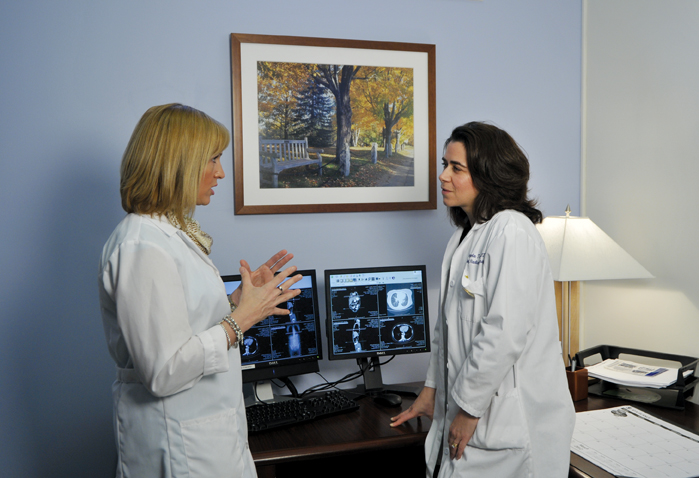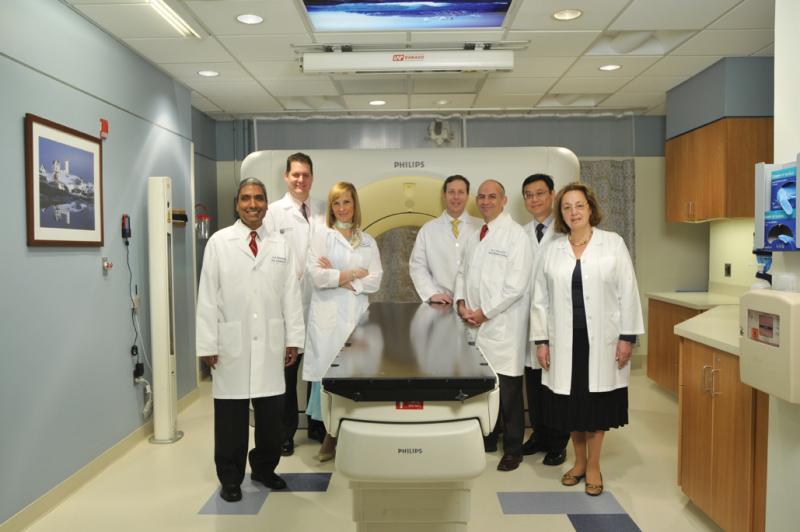
Andrea B. McKee, M.D., and chief therapist Angela Tambini review a patient's CT films.
The National Lung Screening Trial (NLST) was a National Cancer Institute sponsored trial that began in 2002. This randomized controlled trial examined more than 50,000 patients who were classified as being at high risk for the development of lung cancer — they had smoked at least 30 pack years (one pack per day for 30 years or two packs per day for 15 years); they were between 55 and 74; and they were either current smokers or former smokers who had quit within the past 15 years. The trial aimed to see whether screening with low-dose computed tomography (CT) improved outcomes over screening with chest radiography. It was halted early in October 2010 when a 20 percent mortality benefit was observed in the low-dose CT arm.
After the results of the NLST were released, the National Comprehensive Cancer Network (NCCN), a large, not-for-profit association made up of 23 of the leading cancer centers throughout the country, issued their strongest recommendation (category 1) for CT screening for high-risk patients — based on high-level evidence there is uniform NCCN consensus that intervention is appropriate. It was this recommendation that gave the physicians and administration at the Lahey Hospital & Medical Center (LHMC) in Burlington, Mass., the push they needed to implement a lung screening program.
Ethical Imperative
“When we heard the NLST results, we knew that lung screening was going to be important in this country because lung cancer is the No. 1 killer of both men and women in the U.S., killing more women than breast, uterine and ovarian cancer combined,” said Andrea B. McKee, M.D., chairman, radiation oncology, Sophia Gordon Cancer Center, LHMC. Although the hospital knew that creating a screening program would help save lives, there was an obvious financial roadblock. “There’s no established reimbursement for lung screening so the patient, if they hear about this information and they want to get screened, would have to nowadays pay anywhere from $99-1,000 out-of-pocket,” McKee explained.
Due to the benefit of CT screening for this high-risk population, McKee and Brady McKee, M.D., section chief — thoracic imaging, radiology, LHMC, tried to establish a screening program at LHMC, which was initially not free. Over a nine-month trial period, the program screened only four patients at the rate of $350 each. “That is when Brady said you know what, this has got to be free or no one is going to come,” explained McKee.
Back to the Drawing Board
LHMC convened a steering committee to see how it could move forward with a free lung screening program. The first item of business was to create a plan that demonstrated LHMC could financially support a free program by using the center’s existing CT capacity. “When we start in the morning we give an injection to an oncology patient for the PET scan and then we can’t actually scan the patient for about an hour because the FDG in the PET has to be physiologically utilized before you can scan the patient. During that one hour when the team is already there, and the scanners are already turned on, we can scan five lung screening patients,” Andrea McKee said.
This concept allowed the Rescue Lung, Rescue Life program to move forward with their existing workforce. According to Stacey Scott, patient navigator, Lung Cancer Screening Program, LHMC, the main additional cost for the program — the cost of getting a radiologist to interpret the exams — is estimated to be around $60 a scan. Although the program screens anywhere from 40–50 patients a week, they have not required overtime teams for assistance, and hours have not needed to be expanded in order to meet the demand.
A Self-Sustaining Venture
Not only could LHMC support free lung screening, the program turned out to be a self-sustaining venture. While constructing the business model, the staff looked at the low-dose CT arm of the NLST and saw the percentage of patients who came back after initial screening diagnosis to have bronchoscopies, follow-up interval CT, positron emission tomography (PET) scans and chest radiographs. As McKee explained, “Once a nodule is established, if there is further follow-up that needs to come as a result of the screening study, then that test is considered a diagnostic test. It’s no longer a screening test, and would be billed to that patient’s insurance per the usual process.”
Once the staff at LHMC saw these percentages, they were able to run modeling and calculations showing that follow-up treatment from lung screening could subsidize costs incurred by the free program. “As long as a certain number of people come back for treatment, we can support the cost of the database and the personnel to staff the program,” explained Brady McKee.
Developing the Database
An integral part of the free lung screening program was the development of the LungRADS reporting system. According to McKee, one of the most difficult things for primary care physicians to do is figure out the next steps for care based on the results of a lung CT scan. “It’s just overwhelming for them to be getting reports with these findings and not really knowing what to do,” she said. The LungRADS reporting system, which operates much like BI-RADS for mammography screening, follows the NCCN Guidelines for lung screening and helps physicians understand how to manage findings. “When a primary care physician gets one of our reports, it says, OK, there is a 5 mm nodule. According to the NCCN, the patient needs to come back in six months for a low-dose CT scan,” McKee explained. Based on this information, lung screening center staff can schedule follow-up appointments within their own database and keep track of both the findings and the patients. The primary care physician is thereby assisted in what needs to be done and is requested to write an order for the next scan if that is the only follow-up indicated at that time.
The LungRADS system has also proven to be beneficial as a quality improvement tool. Unnecessary CT scans can increase false positives and unnecessary biopsying. The administration at Rescue Lung, Rescue Life has found that having a system that tells physicians how to proceed based on specific findings reduces unnecessary testing, healthcare costs and patient anxiety. For example, although a 5 mm nodule may be found on a lung CT scan, research on lung cancer states that 96 percent of nodules less than 5 mm are not cancer, so there is no need to biopsy these nodules unless they have shown growth over time. The LungRADS system helps physicians navigate these types of situations.
The administration foresees LungRADS being a useful data mining tool in the future by allowing patients to be triaged into risk groups within this already high-risk population. Based on nodule size and characteristics of what has happened over time, LungRADS identifies the patients who require additional evaluation. Using the reporting system, staff at the screening program were able to see that within the first 500 patients, only 17 actually had a nodule over 8 mm that needed to be sent to pulmonary medicine to decide if a biopsy was needed. McKee stated that in the future it is possible this information will tie to reimbursement.
If You Build It, They Will Come
Because Rescue Lung, Rescue Life had little to no budget, program leaders had to engage and educate primary care physicians at LHMC so that they were aware of the program and could refer patients. The staff developed a continuing medical education campaign where they went to the different practices in and around LHMC and gave PowerPoint presentations allowing physicians the chance to have questions answered. Physicians saw that the program was run just like mammography and that the reports would all be linked to decisions.
Due to this education and cooperation of physicians, Rescue Lung, Rescue Life never took out an ad in a major publication or on a billboard, or even spoke directly to the patient population to market the program. The only thing that the administration did was put out an e-mail on the hospital’s intranet site to get LHMC employees screened. This helped to grow the system and database, and work through many of the operational kinks before outside patients began enrolling.
Although the screening program was featured on a local news station health alert for the first time in March, most of the patients already enrolled had heard about the program from their primary care physician. Today, patients interested in lung screening can contact the facility directly, and are provided with a four-page frequently asked questions information packet about lung screening, and also are asked a series of questions to determine if they qualify for lung screening. If they do qualify, an order is obtained from the patient’s physician prior to scheduling the screen. Even without large scale marketing, more than 1,022 patients from every demographic have enrolled in the program since it went live in January 2012, and the hospital has treated six cancers based on the findings.
The Right to Choose
Offering a free lung screening program to patients tackles the healthcare disparity issue and makes things easy and fair for all. Although free lung screening has proven to be a self-sustaining venture and grants are available that organizations can apply for, Brady McKee stated that it might not be the route that all organizations are ready to take. There are many factors that go into deciding whether or not an organization can support a free screening program, including the hospital and local environment. However, due to the apparent benefits of CT to high-risk populations, he explained that patients need to be informed of the risks and benefits associated with lung CT screening, including false positives, false negatives and overdiagnosis issues. Once educated, they should then be given the option to choose regardless of whether the organization offers free screening. “What I would hate to see in a year
or two is patients diagnosed with late-stage lung cancer who were never given the opportunity to make that decision,” he said. “I think the discussion must be had and if patients need to pay $300 out-of-pocket they need to be given that choice, and they need to be able to make that decision.”



 December 10, 2025
December 10, 2025 









